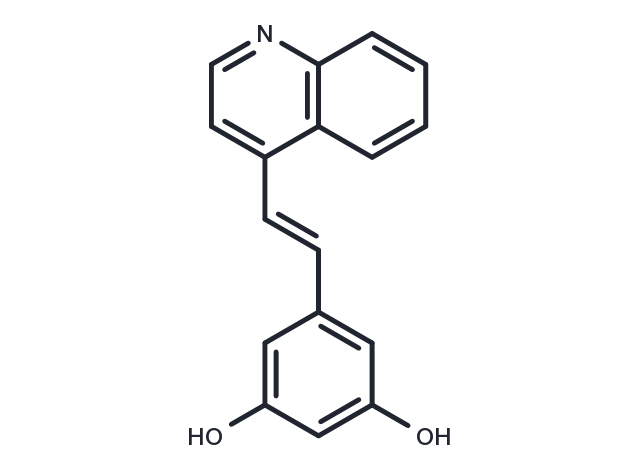Powder: -20°C for 3 years | In solvent: -80°C for 1 year


RV01 is a novel quinoline-substituted analogue of resveratrol that inhibits DNA damage, reduces ethanol-induced acetaldehyde dehydrogenase (ALDH2) mRNA expression, and has hydroxyl radical scavenging activity. rV01 reduces iNOS expression and has anti-neuroinflammatory effects. rV01 reduces tumor necrosis factor-a (TNF-a) and interleukin-6 (IL-6) mRNA levels and secretion. RV01 reduced tumor necrosis factor-a (TNF-a) and interleukin-6 (IL-6) mRNA levels and secretion, inhibited lps-induced ROS production and nicotinamide adenine dinucleotide phosphate (NADPH) oxidase activation, decreased toll-like receptor 4 (TLR4) protein expression, and inhibited lps-induced activation of mitogen-activated protein kinase (MAPK) and nuclear transcription factor-кB (NF-кB) signaling pathways.

| Pack Size | Availability | Price/USD | Quantity |
|---|---|---|---|
| 1 mg | In stock | $ 116.00 | |
| 5 mg | In stock | $ 289.00 | |
| 10 mg | In stock | $ 455.00 | |
| 25 mg | In stock | $ 753.00 | |
| 50 mg | In stock | $ 1,060.00 | |
| 100 mg | In stock | $ 1,430.00 | |
| 500 mg | In stock | $ 2,860.00 | |
| 1 mL * 10 mM (in DMSO) | In stock | $ 287.00 |

| Description | RV01 is a novel quinoline-substituted analogue of resveratrol that inhibits DNA damage, reduces ethanol-induced acetaldehyde dehydrogenase (ALDH2) mRNA expression, and has hydroxyl radical scavenging activity. rV01 reduces iNOS expression and has anti-neuroinflammatory effects. rV01 reduces tumor necrosis factor-a (TNF-a) and interleukin-6 (IL-6) mRNA levels and secretion. RV01 reduced tumor necrosis factor-a (TNF-a) and interleukin-6 (IL-6) mRNA levels and secretion, inhibited lps-induced ROS production and nicotinamide adenine dinucleotide phosphate (NADPH) oxidase activation, decreased toll-like receptor 4 (TLR4) protein expression, and inhibited lps-induced activation of mitogen-activated protein kinase (MAPK) and nuclear transcription factor-кB (NF-кB) signaling pathways. |
| In vitro | The anti-neuroinflammatory effect of a novel quinolyl-substituted analogue of resveratrol (RV01) on lipopolysaccharide (LPS)-induced microglial activation is investigated, as well as the possible underlying mechanisms. Cell viability is measured using an MTT assay. Nitric oxide (NO) release is determined by nitrite assay. Free radical scavenging activity and reactive oxygen species (ROS) production are determined by DPPH reduction assay and DCFH-DA assay. Pretreatment with RV01 (1-30 µm) prior to LPS (1 µg mL-1 ) stimulation decreased NO release and iNOS expression without observable cytotoxicity. RV01 reduced the mRNA levels and secretion of tumor necrosis factor-α (TNF-α) and interleukin-6 (IL-6). RV01 also inhibited LPS-induced ROS production and nicotinamide adenine dinucleotide phosphate (NADPH) oxidase activation. Furthermore, RV01 decreases the protein expression of toll-like receptor 4 (TLR4) and inhibits the LPS-induced activation of the mitogen-activated protein kinase (MAPK) and nuclear transcription factor-κB (NF-κB) signaling pathways. Additionally, conditioned medium from microglia co-treated with LPS and RV01 alleviates the death of SH-SY5Y cells induced by conditioned medium from activated N9 microglial cells. Lastly, a mouse neuroinflammation model is further used to confirm the effect of RV01 in vivo. These results show that RV01 suppresses microglia-mediated neuroinflammation and protects neurons from inflammatory damage.[2] |
| Molecular Weight | 263.29 |
| Formula | C17H13NO2 |
| CAS No. | 1016897-10-1 |
Powder: -20°C for 3 years | In solvent: -80°C for 1 year
DMSO: 4.5 mg/mL (17.1 mM), Sonication is recommended.
You can also refer to dose conversion for different animals. More
bottom
Please see Inhibitor Handling Instructions for more frequently ask questions. Topics include: how to prepare stock solutions, how to store products, and cautions on cell-based assays & animal experiments, etc.
RV01 1016897-10-1 Others RV-01 RV 01 inhibitor inhibit
